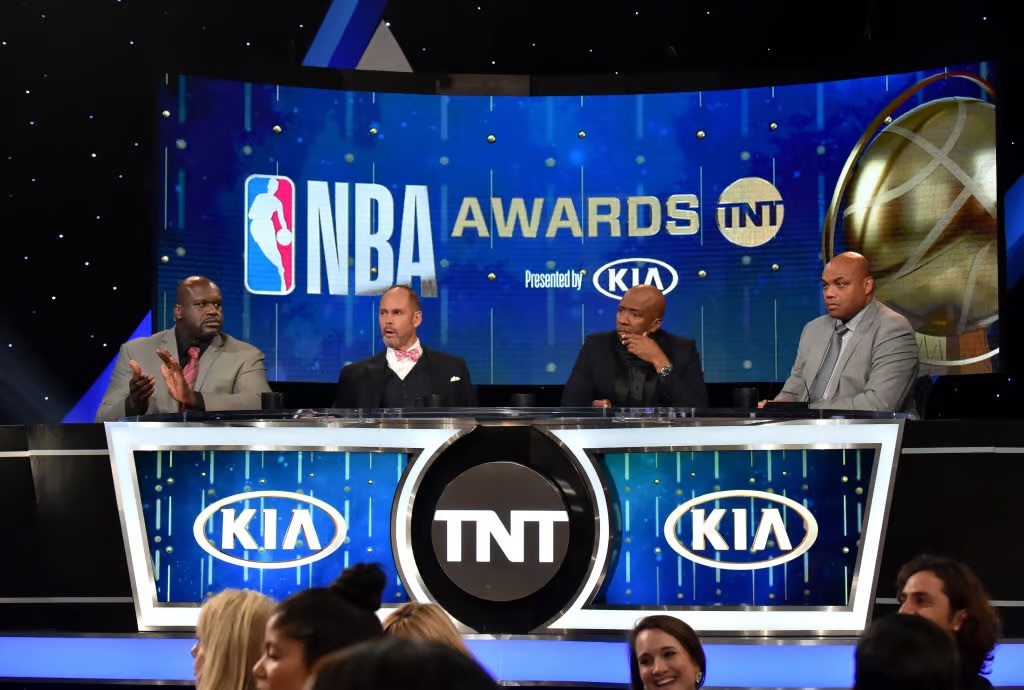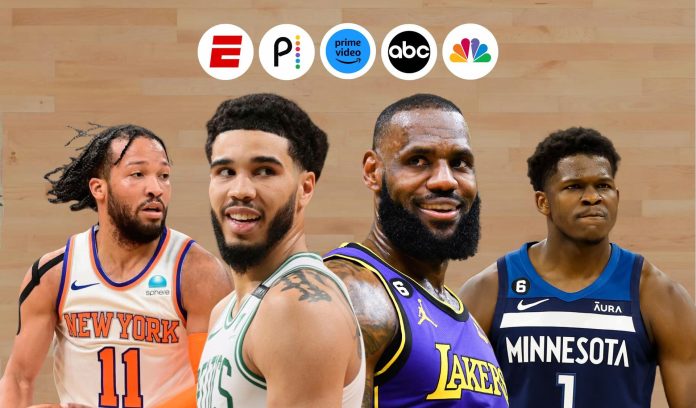A look inside the NBA media rights landscape as ESPN, NBC, and Amazon all look for marquee talent going into the new $77 billion deal
(Boardroom) — The 2024-25 NBA season tips off on Tuesday, beginning the final year of the current NBA media rights deal and a massively impactful transitional year that will impact how we watch professional men’s basketball for the next decade.
To quickly recap, here’s what’s changing after this coming season: The NBA signed an 11-year, $77 billion deal with ESPN/ABC, Amazon‘s Prime Video, and NBC/Peacock in addition to an 11-year, $2.2 billion WNBA deal with the same partners. The previous contract signed in 2014 was for $24 billion. It will mark the end of Turner Sports‘ 40-year relationship with the NBA, with Warner Bros. Discovery suing to keep TNT part of the NBA going forward, claiming the NBA’s matching rights pact with Amazon was unfair.
What you’ll see in the next rights era is a greater emphasis on broadcast and streaming and a decreased focus on cable. NBC will air national games on Sundays after the NFL season and every Tuesday during the regular season, while ABC will continue its premium national slate on weekends. Prime Video will stream 66 regular season games per year, including Thursdays after the NFL season and every Friday, while Peacock will host a doubleheader each Monday.
“The large increase we got was because we dramatically increased the number of broadcast exposures,” NBA Commissioner Adam Silver said last week at Columbia University’s Sports Management Conference. “And then the rest was largely due to the belief that live premium sports can drive the streaming marketplace.”
The deal also reflects cable’s decline, with subscriptions and revenue plummeting as streaming services and skinny bundles take huge bites out of the once-dominant model. ESPN will be more reliant on its direct-to-consumer business, while WBD experiences a steady decline — not to mention roughly $40 billion in debt — and lacks the stability of Disney, Amazon, and Comcast, which Silver hinted at last week being a factor in who the NBA partnered with long term.

Ahead of the opening whistle next week, Boardroom analyzes the NBA media rights landscape, diving deep into the league’s local streaming strategy while also paying homage to a media show staple and breaking down the race for broadcast talent.
The End of an Era
Unless WBD pulls off the legal miracle of our lifetimes, it will be the last year of NBA coverage for a network that helped the league transition into the modern age and globalize the sport. With few exceptions, like Vince Carter joining as a studio analyst, legendary producer Tim Kiely coming out of retirement for one last season, and longtime play-by-play man Brian Anderson signing an extension to lead its long-term baseball and golf coverage, major talent will need to find new hoops homes moving forward.
For Inside the NBA, the greatest studio show in sports history, the show’s likely premature end as currently constituted likely has other networks licking their chops at the chance to bring in Charles Barkley, who’s on a long-term contract with WBD but can we really see him not commentate on basketball every week? While Ernie Johnson will likely stay at Turner, Barkley, Shaquille O’Neal, and Kenny Smith should be hot commodities.
The same can be said for other TNT broadcast talent, including Kevin Harlan, Ian Eagle, Reggie Miller, Stan Van Gundy, Candace Parker, Grant Hill, and Allie LaForce. Dwyane Wade still has duties with WBD and CBS for the men’s college basketball tournament, but his excellent Olympic basketball run this past summer has him in even higher demand from NBC and ESPN, the latter reportedly wanting him to boost its studio programming.
For so many in the NBA talent industry, especially at WBD, the next year will be a high-stakes game of musical chairs for landing new gigs.
“This is an unprecedented time in our industry,” Jake Fischer, a longtime NBA insider and former Sports Illustrated and Yahoo writer who’s himself now a free agent, told Boardroom. “With two new rights holders set to take over in and the lead reporter in the sport’s history stepping aside, the next few years will operate much differently than we ever have.”
The Race for Talent
As we get towards the beginning of the new rights deal, how will ESPN, Amazon, and NBC arm themselves with marquee talent?
Due to layoffs or defections, there’s been an ESPN NBA brain drain lately — Mark Jackson, Jeff Van Gundy, Adrian Wojnarowski, Zach Lowe, JJ Redick, and Doc Rivers all out over the last year-plus at the network. While Shams Charania replaced Woj, who Fischer just alluded to, as the network’s lead NBA scoop master, Michael Grady was added as a new play-by-play man and larger roles were given to internal basketball veterans Tim Legler, Jay Bilas, and Kendrick Perkins. But those feel like short-term Band-Aids, and ESPN executives must know they need to upgrade NBA talent across the board.
While NBC likely already has its top two play-by-play announcers in Mike Tirico and Noah Eagle, a ready-made studio host in Maria Taylor, and strong complementary options in Zora Stephenson and LaChina Robinson, it has to build out the rest of its NBA roster from scratch. When the NBA on NBCreturns for the first time in more than 30 years and puts primetime games on broadcast twice a week, you know they’re going to put on the full-court press for the biggest names in the game.
To date, Amazon has kept close to the vest on its NBA ambitions as it gets into the space working from scratch. But, a source tells Boardroom that Prime Video is working behind the scenes to lure bold-faced names mentioned previously in this article. It’s logical to expect them to mirror its NFL strategy for talent acquisition, where it also built out a mix of established names like Al Michaels and former players with little previous broadcast experience like Richard Sherman, Ryan Fitzpatrick, and Marshawn Lynch who would grow into their roles.
Plenty of other reporters and analysts are now free agents looking for strong landing places before the new rights deal begins. Chris Haynes, Jamal Crawford, Fischer, and Lowe will all be in strong positions to angle for rights holder deals should they choose, though writers could potentially go out on their own in a newsletter format like former ESPN NBA insider Marc Stein does at Substack.
Over the next year, before the media rights deal kicks off, expect huge turnover and change within the industry that will reset the market for years to come.
The NBA’s Local Streaming Strategy
“Before we ever entered into these new national deals,” Silver said last week at the Columbia conference, “of our 30 teams, we were looking at roughly 18 of those teams either dealing with completely defunct or bankrupt RSNs.”
With Diamond Sports Group‘s bankruptcy leaving local deals for more than half the teams in the league in peril on Bally Sports, several teams, including the Phoenix Suns, Utah Jazz, Los Angeles Clippers, New Orleans Pelicans, Houston Rockets, Dallas Mavericks, and Portland Trail Blazershave started their own networks or switched to local TV with direct-to-consumer subscription models for out of market viewers. Premium live sports isn’t working locally, Silver said, with a model still largely dependent on the declining cable industry.
Not only are cable providers losing subscribers en masse, but you also have streaming and skinny bundles chopping revenues and ensuring NBA RSNs aren’t nearly as profitable as they once were. How the NBA, MLB, and NHL handle these local rights moving forward, whether maintaining the current model or trying to nationalize local schedules, will also help shape how American sports fans watch their favorite teams for many years to come.
A year from now, NBC and Amazon’s entry into the NBA universe will mark a change we haven’t seen in the league in more than 20 years. The three networks and the talent who will drive their air time and content are now working tirelessly behind the scenes to secure their spots and not be left standing when the music finally stops.








